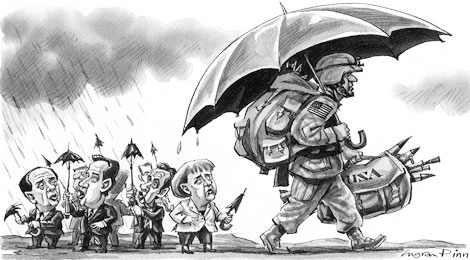The recent announcement that the Obama administration plans to cut two of the four remaining US brigade combat teams (BCTs) in Europe came as no surprise to those tracking the ongoing debate over the future size of the American military and the Army in particular. Assuming the Army is getting smaller, it’s obviously easier to draw down units based in Europe than in a place like Georgia or Texas, since there are of course no US Congressmen or Senators representing Grafenwoehr, Germany or Vicenza, Italy.
What will probably come as a surprise to many, though, is that such cuts are unlikely to result in any appreciable defense budget savings over time, and if they do they’ll likely prove highly damaging to US national security interests in the long run as it becomes more difficult to maintain interoperability with our most likely, most capable future coalition partners.
The commonly held view that US forces in Europe are still guarding the Fulda Gap against a revanchist Russia is mistaken. Given the lack of serious threats to allied territory in Europe, few analysts outside of perhaps Warsaw or Tallinn – who still don’t trust their much larger neighbor to the east despite its limited military capabilities – regard defending alliance territory and deterring potential aggression as the primary mission of US forces in Europe. Instead, the three most important functions of American military presence in Europe today are to maintain interoperability with existing capable allies; to build partner capacity among newer, less capable, allies and partners; and to ensure access for military operations beyond Europe.
To those more familiar with the composition of US force structure in Europe, this change in purpose has been obvious. The numbers alone tell the story of a dramatically less powerful and hence at least somewhat less capable US military force in Europe, designed not to take on Russia’s land forces but rather to support American national security in other ways.
The Obama administration’s recently released Defense Strategic Guidance clarifies at least one of those other ways when it notes that the United States will “promote enhanced capacity and interoperability for coalition operations ,” and that “U.S. forces will plan to operate whenever possible with allied and coalition forces.” In cutting US presence in Europe, the Department of Defense believes it can maintain the necessary coalition capability by rotating forces from the continental United States to overseas training events and exercises, but this is problematic for two reasons.
First, the cost of such rotations on an annual basis will quickly add up to an unsustainable level. For example, the transportation costs of implementing the 2012 exercise program of one of those Europe-based brigades – roughly $720,000 – is over 14 times higher when implemented by a similar brigade based in Texas, at about $10.4 million. Therefore, it is very likely that either the US government will achieve little savings as it strives to maintain an adequate level of military engagement overseas or that large training or exercise rotations overseas will become prohibitively expensive and therefore quite rare.
Second, allied interoperability – the basis for future military coalitions – is likely to be far more difficult to maintain with fewer forces based overseas. Periodic rotations of small military training teams sent from America to work with foreign counterparts overseas may help to build some minimal capacity through familiarization visits and classroom interaction. However, the kind of interoperability necessary to ensure success during high intensity coalition operations is most effectively achieved through regular, major military exercises – the kind that forward-based US soldiers in Europe have been doing for decades.
The implications of all this could be quite profound. Reduced interoperability between US forces and those of its most likely, most capable coalition partners means allied forces will be less ready to fight side-by-side with American forces from Day 1 of any future conflict. Moreover, reduced daily interaction between US troops and their European counterparts means American forces themselves will be less prepared to operate in a coalition environment, something they have become quite adept at over the last decade in Afghanistan, where nearly 94 percent of the non-US forces come from Europe.
These factors only serve to increase the risk that America will need to fight the next conflict unilaterally, or at least with fewer foreign forces to rely upon in sharing the burden, meaning more US boots on the ground, for longer periods of time. Although defense cuts are certainly in order today, DoD needs to ensure it doesn’t sacrifice interoperability and coalition capability – something its own strategy claims is vital – in the name of austerity.
John R. Deni is a Research Professor of National Security Studies at the Strategic Studies Institute. The views expressed are his alone, and do not necessarily reflect those of the U.S. Army, the Department of Defense, or the U.S. Government.
Image: ft%204%2016%2011%20Ingram%20Pinn%20Yanks%20going%20home_0.jpg
